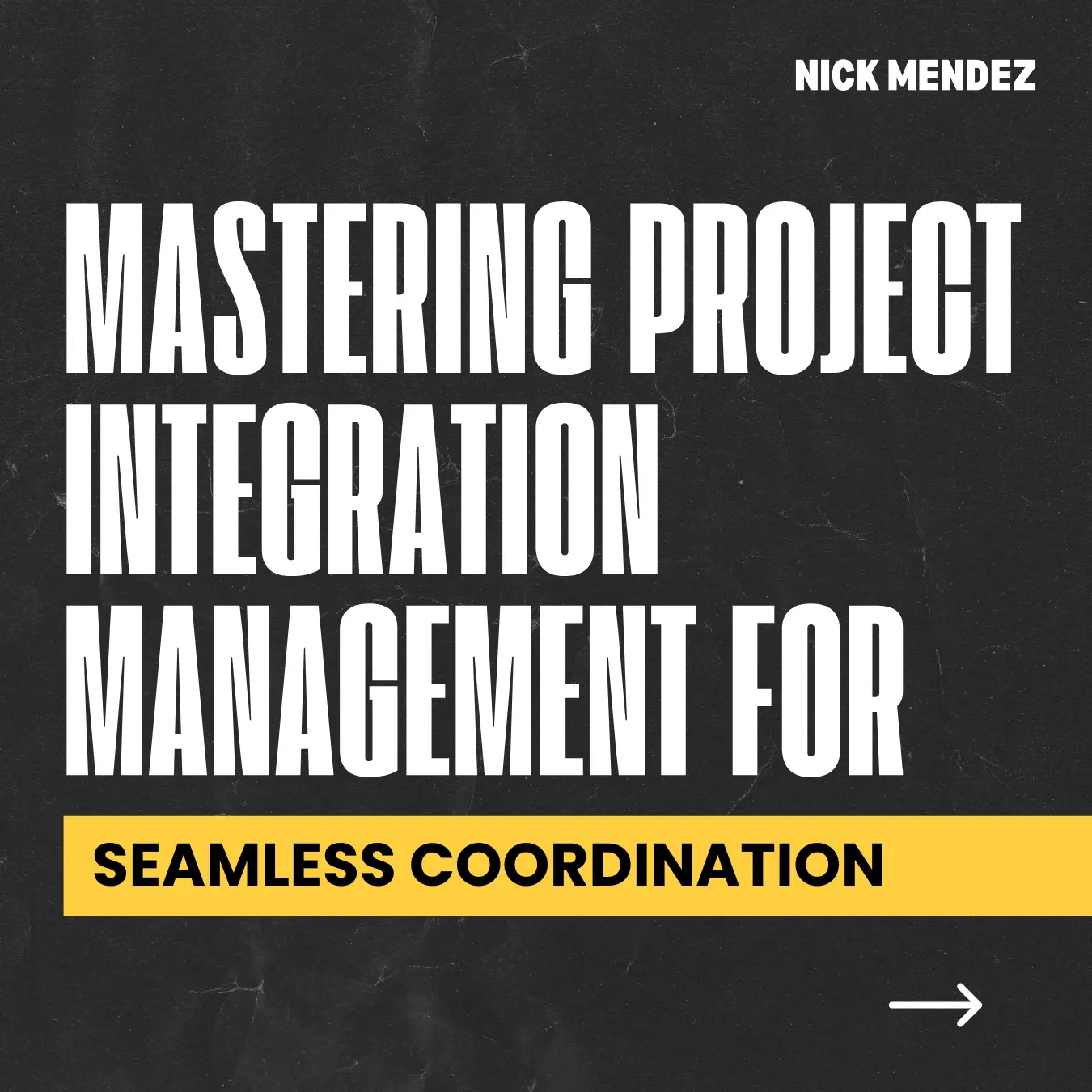Mastering Project Integration Management for Seamless Coordination
Table of Contents

About the Author – About Nicholas Mendez (Nick Mendez):
Nicholas Mendez (Nick Mendez) is a 26-year-old tech professional with 5+ years of cyber security, and technology project management experience. He earned his PMP certification on April 30, 2023, marking a significant milestone in his career. Since then, he’s written many guest posts and blog posts where readers have received a great amount of value and knowledge to prepare for their PMP exam.
Check out his FREE exclusive top-notch PMP study resource at nickmendez.co and his upcoming website teachmeit.co get ready to take your career to the next level!

Did you know that according to the Project Management Institute, organizations that excel in Project Integration Management are 40% more likely to meet their project objectives?
Project Integration Management stands at the forefront of effective project leadership, catalyzing seamless coordination and harmonizing diverse project elements. In the ever-evolving landscape of project management, understanding and mastering Project Integration Management are essential for achieving project success.
Understanding Project Integration Management
To guarantee smooth alignment throughout the project lifecycle, PMI defines project integration management as the coordination and integration of all project elements. This involves orchestrating various components such as scope, schedule, cost, quality, resources, communications, risk, and procurement. Effective integration of these components enables project managers to plan, carry out, monitor, and oversee project activities in a cohesive manner.
This integration increases resource utilization, reduces effort duplication, and promotes efficiency. It also gives project managers the ability to recognize dependencies, foresee risks, and proactively handle difficulties, which improves the resilience and adaptability of the project. Project success and providing value to stakeholders ultimately depend on the integration of project elements.
Developing the Project Charter
The project charter serves as a foundational document that formally authorizes the existence of a project and provides a clear understanding of its objectives, scope, and deliverables. Its purpose is to define the project’s vision, align stakeholders’ expectations, and establish the authority of the project manager.
Typical project charter points:
- Project’s purpose and objectives,
- Stakeholders’ identification
- Project scope
- High-level milestones
- Initial budget and resources
- Project manager’s authority
Creating a comprehensive project charter involves several steps, including defining the project’s purpose and objectives, identifying stakeholders and their roles, outlining the project scope and deliverables, establishing the initial budget and timelines, and obtaining approval from relevant stakeholders.
Developing the Project Management Plan
The project management plan serves as the cornerstone for guiding project execution, providing a comprehensive roadmap that outlines how the project will be executed, monitored, controlled, and closed. Its importance lies in ensuring alignment among stakeholders, facilitating communication, and mitigating risks by establishing clear objectives, scope, timelines, and resource allocations.
Project management plan components:
- Project scope statement
- Schedule
- Budget
- Risk management plan
- Communication plan
- Quality management plan
Techniques including stakeholder engagement, expert judgment, historical data analysis, and iterative refinement are necessary to create a coherent and thorough plan. Project managers can develop a strong project management plan that acts as a framework for effective project execution by combining these strategies and making sure that important elements are included.
Directing and Managing Project Work
Directing and managing project work involves overseeing and coordinating the execution of project activities to ensure they align with the project management plan and objectives. This entails providing guidance, motivation, and support to team members, as well as resolving any issues or conflicts that may arise during project execution.
Effective strategies for executing project activities:
- Establishing clear roles and responsibilities
- Fostering open communication
- Setting achievable goals and milestones
- Monitoring progress regularly
Work breakdown structures (WBS), Gantt charts, performance metrics, and project management software are just a few of the tools and methods that can be used to successfully complete project deliverables. This can often be done within budget and schedule constraints. These tools and techniques can also help to track progress and optimize resource utilization.
Managing Project Knowledge
Managing project knowledge is vital for fostering continuous improvement and organizational learning within project environments. By capturing, sharing, and utilizing project knowledge effectively, organizations can enhance their ability to adapt to changing circumstances, identify best practices, and avoid repeating past mistakes.
Methods for managing project knowledge:
- Documentation
- Lessons learned sessions
- Mentorship programs
- Knowledge sharing platforms
Informed decision-making and innovation are enabled by these techniques, which make it easier for stakeholders and project teams to share insightful knowledge, experiences, and lessons. Lessons learned and knowledge repositories also play a critical role in compiling project experiences, recording successes and failures, and generating a repository of useful information for upcoming projects. Organizations can leverage their collective expertise and promote continuous improvement in project performance and outcomes by utilizing knowledge repositories and lessons learned.
Monitoring and Controlling Project Work
Monitoring and controlling project activities are essential for ensuring that projects stay on track and objectives are met within constraints. Project managers can spot deviations from the project plan, evaluate progress, and identify possible risks or problems early on by keeping a close eye on project performance. This proactive approach enables timely intervention and corrective actions to be taken to keep the project on course and prevent costly delays or overruns.
Techniques for tracking project performance and progress:
- Regular status meetings
- Progress reports
- Milestone tracking
- Performance metrics
Real-time insights into project performance can also aid effective decision-making through the use of tools like earned value analysis, variance analysis, dashboards, and project management software. Throughout the project lifecycle, project managers can ensure successful project outcomes by utilizing these strategies and tools to maintain accountability, visibility, and control.
Performing Integrated Change Control
Integrated change control is a crucial aspect of project management that involves systematically reviewing, evaluating, and approving or rejecting changes to the project scope, schedule, and budget. Its significance lies in its ability to ensure that changes are managed in a controlled manner, minimizing disruption to project progress while maximizing the project’s ability to adapt to evolving circumstances.
The processes for managing changes:
- Identification
- Evaluation
- Decision-making
- Implementation
- Documentation of changes
These processes ensure that changes are thoroughly assessed for their impact on project objectives, risks, and constraints before being approved or rejected.
Effective change control:
- Configuration management systems
- Change control boards (CCBs)
- Change control procedures
- Change request forms
- Impact analyses
By implementing integrated change control processes and using appropriate tools and techniques, project managers can maintain project stability, This mitigates risks and ensures alignment with project objectives throughout the change management process.
Closing the Project or Phase
Proper project closure is essential for ensuring that project objectives are met, resources are appropriately released, and lessons learned are documented for future endeavors. It provides a formal acknowledgment of project completion, facilitates knowledge transfer, and allows for the transition of project deliverables to end-users or stakeholders.
Steps for closing a project or project phase:
- Conducting a final project review
- Obtaining stakeholder acceptance
- Documenting lessons learned
- Archiving project documentation
Activities involved in finalizing project deliverables and obtaining stakeholder acceptance may include conducting final inspections. Sometimes this means obtaining sign-offs, delivering final reports or documentation, and celebrating project success with stakeholders.
Best Practices in Project Integration Management
Ensuring seamless integration and coordination in project management requires a combination of effective communication, stakeholder engagement, and proactive risk management. Tips for achieving this include establishing clear roles and responsibilities, fostering open communication channels, regularly reviewing and updating project plans, and conducting thorough risk assessments.
Common pitfalls:
- Scope creep
- Inadequate communication
- Lack of stakeholder engagement
To avoid these pitfalls that can stall the process, project managers should emphasize proactive risk management, establish clear change control processes, and maintain ongoing communication with stakeholders to ensure alignment and mitigate potential conflicts. By incorporating these tips and learnings from successful case studies, project managers can enhance integration and coordination efforts, leading to improved project outcomes and stakeholder satisfaction.
Wrap Up
For project managers who want to excel in their positions, mastering project integration management is essential. Beyond the foundational importance of aligning project elements and ensuring cohesive execution, mastering integration management unlocks opportunities for innovation and adaptability.
Project managers are better able to facilitate integration, foresee problems, and make proactive decisions when they make use of cutting-edge technologies like artificial intelligence and predictive analytics. Project teams are better equipped to handle complexity by promoting the use of best practices for seamless project coordination, such as agile approaches and collaborative tools.
In the end, integration management is critical to project success because it promotes adaptability, teamwork, and ongoing development all the way through the project’s lifespan. Accepting its strategic importance and utilizing creative methods will drive project managers to produce outstanding results and provide value to stakeholders in a dynamic environment.
